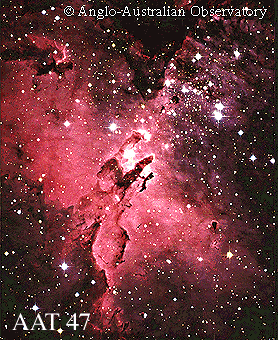
|
Credit & Copyright: Anglo-Australian Telescope
Board
Explanation:
The photogenic
M16 shown above is composed of a
young star cluster associated with a
spectacular emission nebulae
lined with clouds of
interstellar dust.
The gorgeous spectacle lies toward
the galactic center region,
some 7,000 light years distant in
the constellation Serpens.
Most of
the stars in the cluster
can be seen offset just above and to the right of the photograph's center.
This type of star cluster is called an "open" or "galactic" cluster and
typically has a few hundred young bright members. The redness of the
surrounding
emission nebula gas is caused by
electrons recombining
with hydrogen nuclei, while the dark regions are
dust lanes that absorb light
from background sources. The dust absorbs so much light it allows
astronomers to determine which stars are inside the nebula and which are in
the foreground.
Stars are forming within the nebula, also known as
the Eagle Nebula.
|
January February March April May June July August September October November December |
| ||||||||||||||||||||||||||||||||||||||||||||||||
NASA Web Site Statements, Warnings, and Disclaimers
NASA Official: Jay Norris. Specific rights apply.
A service of: LHEA at NASA / GSFC
& Michigan Tech. U.
Based on Astronomy Picture
Of the Day
Publications with keywords: star cluster - M 16
Publications with words: star cluster - M 16
See also:
